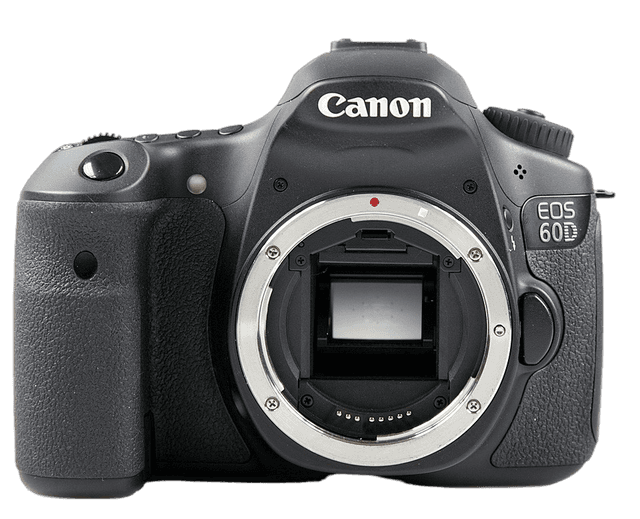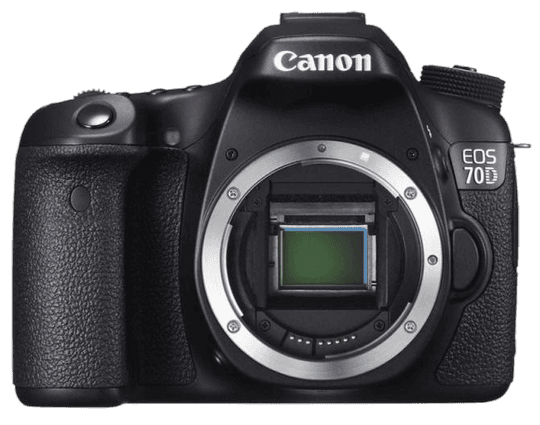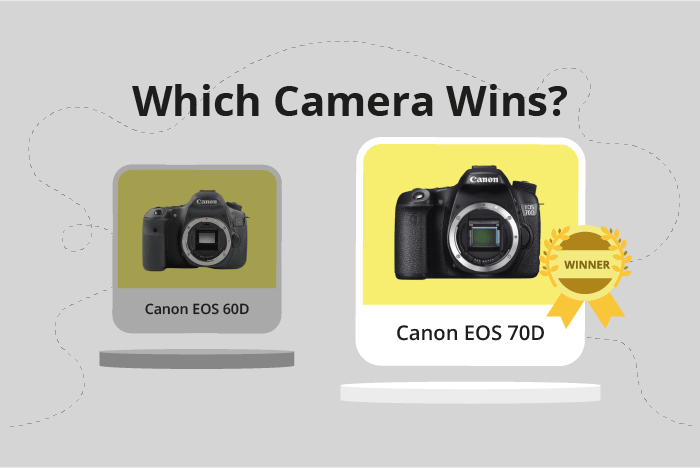Canon EOS 60D vs EOS 70D Comparison
Canon EOS 60D

Canon EOS 70D

The Canon EOS 70D emerges as the winner with a score of 60/100, while the Canon EOS 60D trails behind at 47/100. Both cameras share the same camera type, DSLR, and launch price of $1199. They also have identical weights, coming in at 755g or 1.66lbs.
The 70D has the advantage of being released three years later, in 2013, which means it likely benefits from improved technology. Additionally, it is slightly smaller in size, measuring 139 x 104 x 79mm, making it more compact than the 60D, which measures 145 x 106 x 79mm.
On the other hand, the 60D doesn’t really have any distinct advantages over the 70D. It seems that the 70D simply improved upon its predecessor, making it the better choice for those looking to invest in a Canon DSLR camera.
Canon EOS 60D vs EOS 70D Overview and Optics
The Canon EOS 70D outperforms the Canon EOS 60D in optics, scoring 58/100 compared to the 60D’s 43/100. Both cameras share some common specifications, such as an APS-C sensor size, a CMOS sensor type, a Canon EF-S lens mount, and no image stabilization.
The 70D’s higher score is due to its superior specs in several areas. Firstly, it has a higher megapixel count at 20.2 compared to the 60D’s 18 megapixels, resulting in better image resolution. Secondly, the 70D has a faster shooting speed of 7 frames per second, compared to the 60D’s 5.3 frames per second, allowing for better capture of fast-moving subjects. Additionally, the 70D boasts a more advanced processor, the Digic 5+, which improves overall performance and image processing compared to the 60D’s Digic 4 processor. Lastly, the EOS 70D has a slightly higher DXOMARK sensor score of 68, as opposed to the 60D’s score of 66, indicating marginally better image quality.
However, the 60D does not outshine the 70D in any specific area of optics. The shared features between the two cameras, such as sensor size and lens mount, make their performance in those aspects equal.
Taking these factors into account, the Canon EOS 70D is the clear winner in terms of optics, with better image resolution, faster shooting speed, a more advanced processor, and a slightly higher DXOMARK sensor score. The 60D, while not surpassing the 70D, still provides decent performance with its shared specifications.
Canon EOS 60D vs EOS 70D Video Performance
The Canon EOS 60D and Canon EOS 70D both have a video score of 43/100, indicating that they share similar video capabilities. They have several video specifications in common, including a maximum video resolution of Full HD, maximum video dimensions of 1920 x 1080, and a maximum video frame rate of 30fps. Additionally, neither camera has built-in time-lapse functionality.
Despite having the same video score, each camera has its distinct advantages. The Canon EOS 70D is better in terms of autofocus performance during video recording, as it features Dual Pixel CMOS AF technology, which allows for smoother and more accurate autofocus. This is particularly useful for tracking moving subjects and creating professional-looking videos with ease. The 70D also has a touchscreen LCD, enabling users to quickly adjust focus points and settings during video recording.
On the other hand, the Canon EOS 60D has a slightly better battery life, allowing for longer recording times without needing to change or recharge the battery. This can be beneficial for users who plan to record videos for extended periods or in locations where charging options may be limited.
In comparing the video capabilities of the Canon EOS 60D and Canon EOS 70D, it is clear that both cameras share many similarities. However, the 70D’s improved autofocus performance and touchscreen LCD provide a more user-friendly and efficient video recording experience. While the 60D’s better battery life may be advantageous for some users, the overall video capabilities of the 70D make it a more appealing choice for those looking to create high-quality videos.
Canon EOS 60D vs EOS 70D Features and Benefits
The Canon EOS 70D emerges as the winner with a feature score of 70/100, while the Canon EOS 60D scores 57/100. Both cameras share some common specifications, including a 3-inch screen size and a screen resolution of 1040000 dots. They also both have flip screens and lack GPS and Bluetooth capabilities.
The 70D outperforms the 60D in two key areas: touchscreen functionality and WIFI connectivity. The presence of a touchscreen on the 70D allows for easier navigation and more intuitive control of the camera’s settings. Additionally, the WIFI capability of the 70D enables users to transfer images wirelessly, control the camera remotely, and share photos on social media platforms with ease.
On the other hand, the 60D does not offer any significant advantages over the 70D. It lacks both a touchscreen and WIFI connectivity, making it less user-friendly and less convenient for modern photographers who value seamless connectivity.
Given the similarities in screen size and resolution, as well as the shared flip screen feature, the core differences between the 70D and 60D lie in the 70D’s touchscreen and WIFI capabilities. These additional features contribute to the higher feature score of the 70D and make it a more appealing choice for photographers seeking a user-friendly and connected camera experience. The 60D, while still a capable camera, falls short in these areas and would be better suited for those who prioritize affordability over the latest features.
Canon EOS 60D vs EOS 70D Storage and Battery
The Canon EOS 60D outperforms the Canon EOS 70D in storage and battery with a score of 45/100 compared to the 70D’s 37/100. Both cameras share common specifications, such as one memory card slot and compatibility with SD, SDHC, and SDXC memory cards. Additionally, neither camera supports USB charging, and both use the LP-E6 battery type.
The 60D’s higher score is due to its superior battery life, capable of capturing 1100 shots compared to the 70D’s 920 shots. This longer battery life allows photographers to shoot for extended periods without needing to replace or recharge the battery.
On the other hand, the 70D does not offer any advantages over the 60D in terms of storage and battery features. Both cameras have the same memory card compatibility and lack USB charging capabilities, with the 60D having a longer battery life.
Considering these points, the Canon EOS 60D is the better choice for photographers seeking longer battery life and reliable storage options. The Canon EOS 70D does not provide any benefits in this category, making the 60D a more suitable option for extended shooting sessions.
Alternatives to the Canon EOS 60D and EOS 70D
Are you still undecided about which camera is right for you? Have a look at these popular comparisons that feature the Canon EOS 60D or the Canon EOS 70D:

